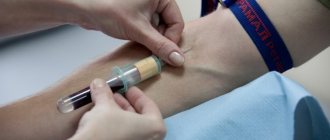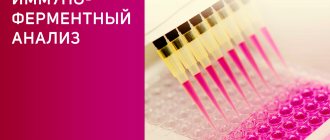Cytomegalovirus: symptoms in adults
When infected, the incubation period can range from 20 to 60 days.
Adults who test positive for cytomegalovirus IgG, IgM, and DNA may exhibit the following symptoms: • Signs of peripheral nerve damage;
• Manifestations similar to ARVI;
• Stomach and intestinal upset;
• Inflammation of the joints - with inflammation of unknown origin, testing for cytomegalovirus IgG, IgM and DNA is positive;
• Chronic fatigue, asthenia and vegetative-vascular dystonia;
• Skin rash;
• Damage to blood vessels of the eyes, brain;
• Signs of damage to the liver, kidneys, bronchi, adrenal glands, etc.
Differences in the number of antibodies to coronavirus
Dear clients and partners!
We invite you to familiarize yourself with the answers to the most frequently asked questions about the difference in IgG values when diagnosing antibodies to the new type of coronavirus, prepared by our medical advisor, Novikova T.E.
What explains the different values of IgG (immunoglobulin G) for COVID- 19 when examined by diagnostic systems from different manufacturers, subject to the condition that test systems for S -antigen are used?
The ELISA test for IgG to coronavirus shows whether a person has antibodies to the SARS-CoV-2 coronavirus and whether he or she has developed immunity.
IgG is a digital parameter; it has a numerical value and, accordingly, a reference value of the indicator, the comparison of which determines the presence of antibodies and immunity to COVID-19. The higher the value, the stronger the body's response to infection.
The reference values of the IgG ELISA test are different in different diagnostic systems. The reference value is always indicated in the test results.
The different IgG values when determining antibodies to COVID-19 are due to the fact that the reference values for each diagnostic system are different, since reagents and equipment from different manufacturers are used.
If IgG is higher than the reference value, the person is considered to be immune to the coronavirus.
Want to compare results? Then do the analysis with test systems from the same manufacturer.
Why do the results at diagnosis and intermediate results during the disease not coincide?
Antibodies of the same class (for example, G) are produced against different parts of the virus - antibodies to the spike protein S, antibodies to the nucleoprotein N, antibodies to the matrix. All research is now focused on 2 significant types of antibodies - to the spike protein S and nucleoprotein N.
- Antibodies are produced to the S spike protein (there are 3 types of antibodies: S1 / S2 / (RDB) (Receptor binding domain). Antibodies to the S protein receptor are produced in the form of neutralizing antibodies that prevent the virus from binding to human cells and immediately begin to protect us. They show the level of individual protective (protective) immune response to SARS-CoV-2.
- Antibodies are produced to nucleoprotein N (it is located inside the virus). The body produces a lot of anti-N antibodies. Recent studies have shown that the level of these antibodies activates cellular immunity, which will protect us for years, i.e. is a marker of past infection.
Different classes of antibodies are produced differently over time, in addition, they are also different even within the same class. For example, Ig G for RDM, Ig G for the S1/S2 epitope, and Ig G for nucleoprotein N are different.
During laboratory testing, it is possible to determine IgG to various coronavirus proteins. Very often they begin to compare results without taking into account the above features. .
“These results suggest that the detection of N protein-binding antibodies is not always associated with the presence of neutralizing antibodies to S-RBD. “Conversely, the presence of S-RBD is the best indicator of protection against re-infection with Covid,” said lead author Raghu Kalluri, MD, professor at the University of Texas.
For example:
- Test system 1 (Novosibirsk): for detection of IgG antibodies to full-length S protein.
- Test system 2 (Germany): for detection of IgG antibodies to S protein (S1 epitope).
- Test system 3 (USA): for detection of IgG antibodies to S protein (S2 epitope).
- Test system 4 (USA): for detection of IgG antibodies to N-protein.
The above IgG antibody detection test kits detect different antibodies by type within a class. Therefore, you can get different analysis results submitted on the same day, because studies can be carried out with various test systems and on various equipment.
Why do the interpretations of the results after vaccination differ for the diagnosis of the disease and the course of the disease?
The vaccine produces only one type of antibodies, and only those who have recovered from the disease have both types.
General:
Each test system has its own reference values, which are indicated as a result of the analysis. You cannot transfer from one system to another, for example, by multiplying by a coefficient, etc.
The Erba Rus company offers the use of ErbaLisa COVID-19 IgG ELISA kits.
When the test for cytomegalovirus IgG, IgM and DNA is positive: transcript
Testing for IgG, IgM antibodies to cytomegalovirus and its DNA in adults is the most reliable way to identify the infection and start treatment on time.
It is especially important to determine infection in pregnant women. If the test result for cytomegalovirus IgG is positive, the risk of intrauterine infection cannot be excluded. Its likelihood is higher if IgG antibodies to cytomegalovirus are detected together with IgM, and also if the IgG concentration exceeds the reference values, which range from 0 to 6 U/ml.
If the cytomegalovirus IgG test result is positive, contact with the virus is confirmed. If the test for cytomegalovirus IgG is positive together with IgM, then we can think about an acute period of infection. If the test for cytomegalovirus IgG is positive, and IgM is positive in a titer of 1:200 or more, the likelihood of a recent primary infection is very high.
A negative result for both antibodies allows one to exclude infection or suspect a seronegative version of it, and may also indicate severe immune suppression.
Determination of class G antibodies to cytomegalovirus (Cytomegalovirus) in the blood
Short description:
IgG antibodies to cytomegalovirus are specific immunoglobulins produced in the human body during the period of pronounced clinical manifestations of cytomegalovirus infection and are a serological marker of this disease, as well as a past cytomegalovirus infection. Antibodies of class G (IgG) are present in the blood in the greatest quantities (compared to other types of immunoglobulins). During primary infection, their levels increase in the first weeks after infection and then can remain high for years. In addition to quantity, IgG avidity is often determined - the strength with which the antibody binds to the antigen. The higher the avidity, the stronger and faster the antibodies bind viral proteins. When a person is first infected with CMV, his IgG antibodies have low avidity, then (after three months) it becomes high. The avidity of IgG is used to judge how long ago the initial infection with CMV occurred. Russian synonyms: IgG antibodies to cytomegalovirus (CMV). English synonyms: Anti-CMV-IgG, CMV Antibody, IgG.
Research method: Enzyme immunoassay
Preparing for the study:
• Do not eat for 12 hours before the test. • Avoid physical and emotional stress 30 minutes before the test. • Do not smoke for 30 minutes before donating blood.
Type of biomaterial: Venous blood
Tube Type: Vacuum Tubes with Clotting Activator and Gel (Cap Color: Red with Yellow Ring)
Service price: 199 rub.
Completion time: 3 working days, Tuesday, Friday
Units of measurement: U/ml (unit per milliliter).
Reference values: 0 - 0.5 U/ml.
Negative result during pregnancy • The woman has not previously been infected with CMV - there is a risk of acquiring a primary CMV infection. However, if no more than 2-3 weeks have passed since infection, then IgG may not have appeared yet. To exclude this option, you need to take the test again after 2 weeks.
Positive result before pregnancy • The woman has already been infected with CMV in the past - the risk of complications is minimal.
Positive result during pregnancy • No clear conclusion can be drawn. It is possible that CMV entered the body before pregnancy. But it is possible that the woman became infected recently, at the beginning of pregnancy (several weeks before the test). This option poses a danger to the child. For an accurate diagnosis, the results of other tests are needed (see table).
When trying to identify the causative agent of an unknown disease, a single IgG test provides little information. The results of all tests must be taken into account.
Test results in different situations:
Primary infection: Exacerbation of a long-standing latent CMV infection (the person has been infected in the past) The person is not infected with CMV
IgG test results: absent for the first 1-2 weeks, then their number increases.
IgM: yes (high level).
IgG avidity: low. IgG: yes (quantity increases). IgM: yes (low level).
IgG avidity: high. IgG: present at constant levels. IgM: usually no.
IgG avidity: high. IgG: no. IgM: no.
Code A26.06.022.001
Cytomegalovirus in children
Even during fetal development, cytomegalovirus in children can provoke birth defects and health problems. Therefore, tests for IgG antibodies to cytomegalovirus and for the detection of DNA to the virus are included in the list of tests for TORCH infections (herpes, toxoplasma, rubella and CMV), which are necessary for all women during pregnancy or when planning it.
If CMV infection occurs in the early stages of pregnancy, the risk of miscarriage is very high. In cases where the infection enters the body in late pregnancy, cytomegalovirus in children may not manifest itself for a long time. The child remains a carrier of the virus and faces periodic exacerbations due to decreased immunity. IgG antibodies to cytomegalovirus are detected in his blood and the IgG cytomegalovirus test is positive. IgG and IgM antibodies to cytomegalovirus are found in 10-15% of adolescents.
In what cases is a study prescribed?
• to assess the presence and level of specific antibodies to SARS-CoV-2 as a result of past infection (including asymptomatic); shows the current level of protection against re-infection with coronavirus • An auxiliary study for the diagnosis of COVID-19, in addition to PCR tests (IgG tests should be carried out after 2 weeks from the onset of the disease); • assessment of the immune response to vaccination (with vaccine preparations using S-protein, including Gam-COVID-Vac - Sputnik V, Kovivak).
What exactly is determined during the study? IgG are specific markers of protective immunity. The study is automated, performed by ELISA using Vector-Best test systems, Russia.
What do the test results mean?
The issuance format is quantitative, in the form of the exact amount of virus-neutralizing antibodies to the surface protein of coronavirus (S protein) in 1 ml of blood serum (numeric value)
The resulting figure must be compared with reference values: Negative result - less than 10 bau/ml Positive result - more than 10 bau/ml
According to the manufacturer, all samples with a specific IgG concentration of 150 BAU/ml or higher have high virus-neutralizing activity. At a concentration of 80-140 BAU/ml, the probability of having high virus-neutralizing activity of the serum is 50%.
The advantage of our test is that the result will be given in international units recommended by WHO (BAU/ml - binding antibody units in 1 ml)
Cytomegalovirus: treatment
With a diagnosis that is confirmed when testing for cytomegalovirus IgG, IgM and DNA is positive, treatment should be comprehensive. First of all, if the test for IgG, IgM and DNA is positive, treatment should be aimed at strengthening the human immune system.
With active manifestations of cytomegalovirus, treatment is also aimed at improving liver function and reducing the symptoms of infection (headache, upset stomach, fever, rash).
If cytomegalovirus is diagnosed, treatment may be required against the background of reduced immunity, as well as as a preventive measure for new exacerbations of the infection.
What is the difference between a quantitative and a semi-quantitative test?
— Quantitative analysis shows the concentration of antibodies, expressed in certain units in the volume of biological material (for example, units/ml) — Semi-quantitative analysis for antibodies. The result is expressed in CP. *Positivity rate (PR) is the ratio of the optical density of a patient's sample to the threshold value. CP - positivity coefficient, is a universal indicator used in enzyme immunoassays. The “positivity rate” shows how many times the level of antibodies in the sample exceeds the threshold level for their recognition.






